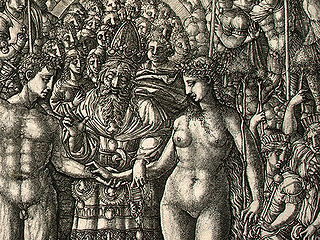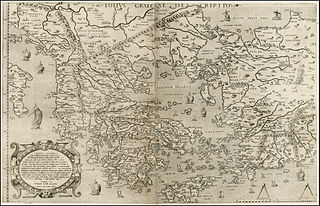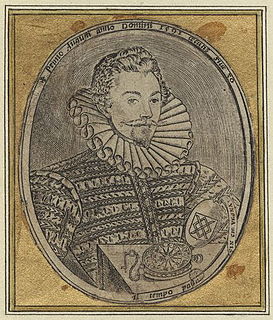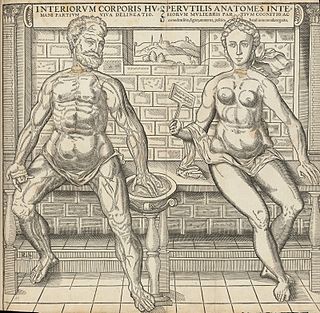
Andreas Vesalius was a 16th-century anatomist, physician, and author of one of the most influential books on human anatomy, De Humani Corporis Fabrica Libri Septem. Vesalius is often referred to as the founder of modern human anatomy. He was born in Brussels, which was then part of the Habsburg Netherlands. He was a professor at the University of Padua (1537–1542) and later became Imperial physician at the court of Emperor Charles V.

Abraham Ortelius was a Brabantian cartographer, geographer, and cosmographer, conventionally recognized as the creator of the first modern atlas, the Theatrum Orbis Terrarum. Along with Gemma Frisius and Gerardus Mercator, Ortelius is generally considered one of the founders of the Netherlandish school of cartography and geography. He was a notable figure of this school in its golden age and an important geographer of Spain during the age of discovery. The publication of his atlas in 1570 is often considered as the official beginning of the Golden Age of Netherlandish cartography. He was the first person proposing that the continents were joined before drifting to their present positions.

John Caius, also known as Johannes Caius and Ioannes Caius, was an English physician, and second founder of the present Gonville and Caius College, Cambridge.

The Great Bible of 1539 was the first authorised edition of the Bible in English, authorised by King Henry VIII of England to be read aloud in the church services of the Church of England. The Great Bible was prepared by Myles Coverdale, working under commission of Thomas, Lord Cromwell, Secretary to Henry VIII and Vicar General. In 1538, Cromwell directed the clergy to provide "one book of the Bible of the largest volume in English, and the same set up in some convenient place within the said church that ye have care of, whereas your parishioners may most commodiously resort to the same and read it."
This article presents lists of literary events and publications in the 16th century.

De Humani Corporis Fabrica Libri Septem is a set of books on human anatomy written by Andreas Vesalius (1514–1564) and published in 1543. It was a major advance in the history of anatomy over the long-dominant work of Galen, and presented itself as such.

Wood engraving is a printmaking technique, in which an artist works an image or matrix of images into a block of wood. Functionally a variety of woodcut, it uses relief printing, where the artist applies ink to the face of the block and prints using relatively low pressure. By contrast, ordinary engraving, like etching, uses a metal plate for the matrix, and is printed by the intaglio method, where the ink fills the valleys, the removed areas. As a result, wood engravings deteriorate less quickly than copper-plate engravings, and have a distinctive white-on-black character.

William Faithorne, often "the Elder", was an English painter and engraver.
Nicholas Hill was a native of the Low Countries who came to England in 1519 and took out letters of denization in 1544. In 1546 the first book with his name in the imprint was issued, and between then and 1553 he printed twenty-three books, mostly for other people. He appears to have done no retail trade as a bookseller and this is probably the reason his house had no sign. He died about 1553.

Theodor de Bry was an engraver, goldsmith, editor and publisher, famous for his depictions of early European expeditions to the Americas. The Spanish Inquisition forced de Bry, a Protestant, to flee his native, Spanish-controlled Southern Netherlands. He moved around Europe, starting from his birth on the city of Liège in the Prince-Bishopric of Liège, then to Strasbourg, Antwerp, London and Frankfurt, where he settled.

Bernardino Genga (1620–1690) was a scholar of Classical medical texts, editing several works of Hippocrates. He also had a great interest in the preparation of anatomical specimens as well as the anatomy of ancient Greek and Roman sculpture. These interests led to his work at the French Academy in Rome, where he taught anatomy to artists.

Jean Duvet was a French Renaissance goldsmith and engraver, now best known for his engravings. He was the first significant French printmaker. He produced about seventy-three known plates, that convey a highly personal style, often compared to that of William Blake, with very crowded compositions, a certain naive quality, and intense religious feeling. According to Henri Zerner, his work has a "freedom and immediacy that have no equivalent in Renaissance printmaking". A degree of mystery surrounds his biography, as there is disagreement as to whether or not he was the Jean Duvet from Dijon who spent sixteen years in the militantly Calvinist city-state of Geneva.

Totius Graeciae Descriptio refers to an early antiquarian map of Greece drawn by Renaissance humanist Nikolaos Sophianos that became a cartographical bestseller of the late 16th century. It is eight pages and shows Greece from mythical times to the founding of the Eastern Roman Empire and the establishment of Christianity. The map draws on many classical historians and thinkers, including Ptolemy, Herodotus, Thucydides, Strabo, and Pausanias.

Thomas Cockson, or Coxon, was one of the earliest English engravers. He left a large number of portraits engraved entirely with the graver in a neatly and finished manner. His first and most recognizable work is one for John Harington's version of Ariosto's Orlando Furioso and his latest, one depicting musketeers and pike men, which depicts on either side the coats of arms of various captains of the time.

Thomas Raynalde was an English physician, known as the translator or editor of Eucharius Rösslin's De Partu Hominis. The translation was published as The Byrth of Mankynde, otherwyse named The Womans Booke in 1545 and was highly successful, running to eleven or thirteen editions and remaining in use until 1654. A Compendious Declaration of the Excellent Vertues of a Certain Lateli Inventid Oile, published in 1551, is believed to have been written by the same person.
John Alday, was an English translator of semi-philosophical and classical works in the reign of Queen Elizabeth I. He was described by Thomas Tanner as a resident of London.

Anatomical fugitive sheets are illustrations of the human body specially created to display internal organs and structures. Hinged flaps enable the viewer to see a body as if in various stages of dissection. They appeared for the first time in the 16th century and became popular as instructional aids. The parts were labelled, making it easier for lay students to understand the workings of the human body.

John Halle, or John Hall of Maidstone was an English surgeon, known as a medical writer and poet.
Anatomes totius is a book written in 1564 by André Vésale and Jacques Grévin.

Crispijn (van) de Passe, also known as Crispijn (van) de Passe the Younger or Crispijn (van) de Passe (II), was a Dutch Golden Age engraver, draughtsman and publisher of prints. He was a member of the large printmaking Van de Passe family, son of the engraver and print publisher Crispijn van de Passe the Elder.

















